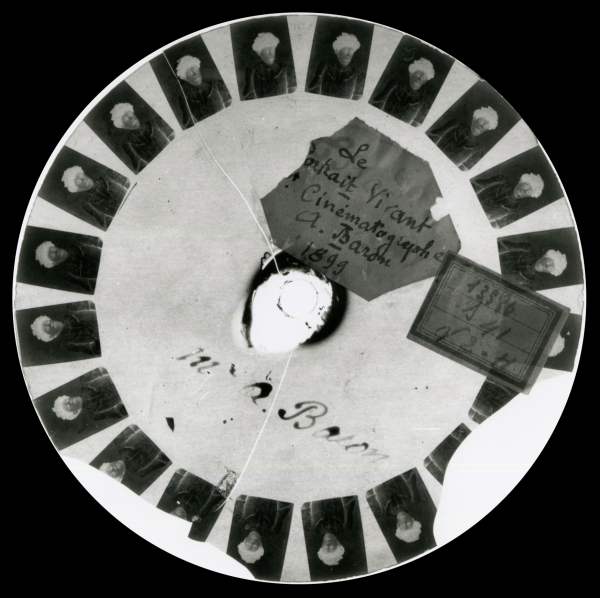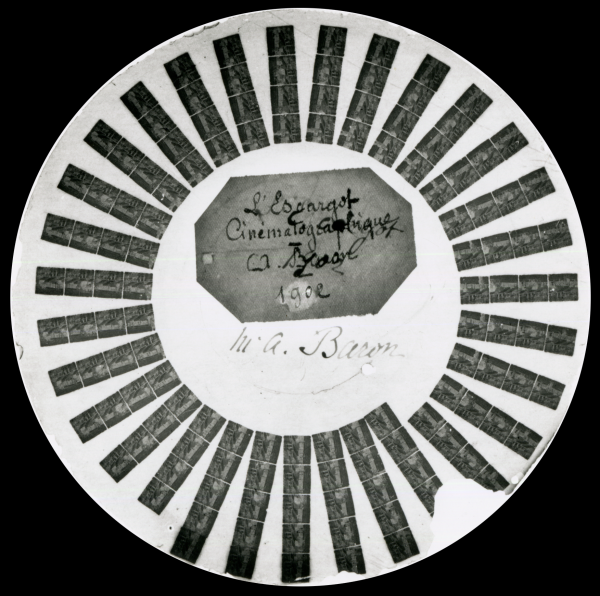A “living portrait”, consisting of a series of 20 or more photographic images glued onto a transparent celluloid disc, measuring 12.5cm (4.92 in), and 17cm (6.69 in), in diameter.
Film Explorer

“Le Portrait vivant pour Cinématographe”, Auguste Baron, 1899. A sequence of photographic images were recorded on photosensitive paper, glued to a celluloid disc 12.5cm (4.92 in) in diameter.
Registre Baron 13-586, Musée des Arts et Métiers, Paris, France.

“L’Escargot Cinématographique”, Auguste Baron, 1902. A later version of Baron’s disc captured 130 images on a 17cm (6.69 in) disc, in a spiral arrangement.
Registre Baron 13-586, Musée des Arts et Métiers, Paris, France.
Identification
0.71:1 (1899), or 1.1:1 (1902)
Disc: either 125mm (4.92 in), or 170mm (6.69 in), in diameter.
Approximately 12mm x 17mm (0.472 x 0.669 in) (1899) or approximately 8.90mm x 8.09mm (0.350 in x 0.319 in) (1902).
B/W
None
History
Auguste Baron was the inventor of several early moving image devices, including a “Machine system for perforating photographic film and other materials in ribbon form” (Patent no. 256926, 1896); and a “Device for animated circular projections known as cinematorama” (Patent no. 261650, 1893). He earned a place in the history of cinema through his experiments with motion picture sound synchronisation, which began in 1896 and resulted in his Graphophonoscope (“Advanced apparatus for simultaneously recording and reproducing animated scenes and the sounds that accompany them” [Patent no. 276628, filed on 4 April 1898]). The main feature of the Graphophonoscope was a synchronism mechanism that linked the reversible camera/projector and the recording and reproducing phonograph.
In 1899, reverting to earlier pre-cinema devices – Jan Évangéliste Purkyne’s Kinesiskope (1850); and Georges Demenÿ’s Phonoscope (1892) – Baron presented a “living portrait” (Portrait vivant) consisting of a series of 20 photographic images 12mm (0.472 in) wide and 17mm (0.669 in) high, glued to a transparent celluloid disc. The images reproduced the movements of a woman turning her head. The disc, kept at the Musée des Arts et Métiers in Paris, is 12.5cm (4.92 in) in diameter. In 1902, the celluloid disc was increased to 17cm (6.69 in) in diameter: photosensitive paper and contained 31 radial rows of 4 and 5 images, arranged in a spiral pattern (a total of 130 images: 25 rows of 4 images; 6 rows of 5 images). He called this device the Escargot cinématographique (“Cinematographic snail”) because of the spiral arrangement of images – reminiscent of the spiral structure of a snail’s shell. Only two other Escargot discs – one positive and the other negative – reproducing the same street scene, are known to exist. No public presentations of the format have been documented (Basile & Mannoni, 1998).
Selected Filmography
The earliest surviving Baron disc is a negative of a woman turning her head. It is 20 frames long and is preserved at the Musée des Arts et Métiers, Paris.
The earliest surviving Baron disc is a negative of a woman turning her head. It is 20 frames long and is preserved at the Musée des Arts et Métiers, Paris.
The only other surviving Baron discs feature a street scene, 130 frames long. Both negative and positive copies are in the collection of the Musée des Arts et Métiers, Paris.
The only other surviving Baron discs feature a street scene, 130 frames long. Both negative and positive copies are in the collection of the Musée des Arts et Métiers, Paris.
Technology
The only existing evidence relating to Baron’s Escargot cinématographique are the three image discs conserved at the Musée des Arts et Métiers, Paris. No patents were registered and no cameras, projectors, or documentation, appear to have survived. As such, it is hard for historians to conclude exactly how this technology was intended to be photographed or viewed.
Baron’s collaborator, Henri-Louis Huet, went on to patent and market a similar device (Cinématographe Clermont-Huet) in 1903, independently of Baron. That patent describes a camera for recording animated views directly onto a negative disc in a spiral arrangement, and a method to project the images using a separate positive disc.
References
Lecointe, Thierry (2023). “Des photographies aux images animées”, Photographica, 7: pp. 147–159.
Pisano, Giusy & Laurent Mannoni (1998). “Le centenaire d'une rencontre : Auguste Baron et la synchronisation du son et de l’image animée”. 1895, revue d'histoire du cinéma, 26: pp. 3–88.
Pisano, Giusy (2004). “Vers le spectacle: les expérimentations d’Auguste Baron et d’autres pionniers”. In Une archéologie du cinéma sonore, pp. 245–71. Paris: CNRS Editions.
Pisano-Basile, Giusy (2001). “De stroboscopie ten dienste van het onderwijs”. In Maurice Dorikens (ed.), Joseph Plateau: 1801–1883. Leven tussen Kunst en Wetenschap, Gent, Belgium: Provincie Oost-Vlaanderen
Compare
Related entries
Author
Giusy Pisano is professor at ÉNS Louis-Lumière, Noisy-le-Grand, research director at Université Sorbonne Nouvelle Paris 3, member of IRCAV (Institut de recherche sur le cinéma et l'audiovisuel), and a researcher at GRAFICS, Montreal. She is a scientific adviser to the Haut Conseil de l'évaluation de la recherche et de l'enseignement supérieur (Hcéres), and a member of the Cinémathèque française and of the Commission supérieure technique (CST). Her research focuses on the historical and aesthetic issues surrounding film techniques, with reference to media archaeology. She is particularly interested in the relationship between sound and image, and between research and creation. Her publications include: Truquer, créer, innover. Les effets spéciaux français (co-edited with R. Hamus-Vallée & C. Renouard, 2024), La fabrique de l'image au cinéma (co-edited with C. Champetier, 2023), Dispositifs et scènes sonores : du corps (médiatisé) à l'atmosphère (co-edited with J.-M. Larrue & J.-P. Quéinnec, 2019), Machines. Magie. Médias (co-edited with F. Kessler & J.-M. Larrue, 2018) and L'Archive-forme (2014). She has directed several research programmes, including “La mise en scène théâtrale et les formes sonores et visuelles” (2011–14); and with Jean-Marc Larrue, co-directed the project “Les Arts trompeurs. Machines, Magie, Médias” (2015–18). She directs the Images et Sons collection at PUS (Presses Universitaires du Septentrion).
Pisano, Giusy (2024). “Escargot cinématographique”. In James Layton (ed.), Film Atlas. www.filmatlas.com. Brussels: International Federation of Film Archives / Rochester, NY: George Eastman Museum.
Margaux Chalançon


